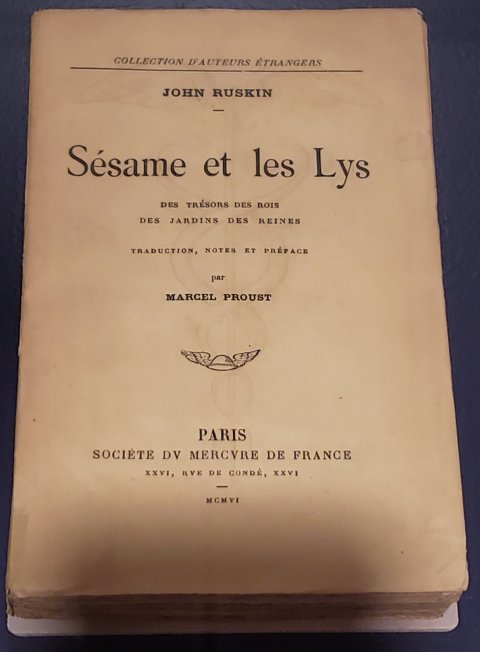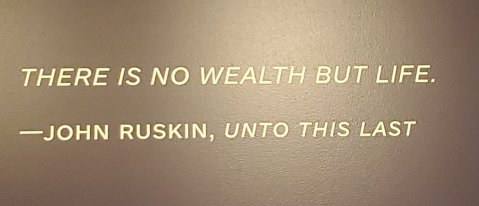
Proust’s translation of Ruskin’s Sesame and Lilles.
In a letter to his English friend, Marie Nordlinger, dated January 1900 Proust writes (trans. Mina Curtiss):
On learning of Ruskin’s death, I cannot keep from thinking of you so poignantly that I must write to you. Not that it needed this to make me think of you. Having been ill for several days, unable to write easily and unwilling to dictate a letter to you, all mo most friendly and grateful thoughts of you, of your letter, of the book [Queen of the Air, by John Ruskin] you sent with its even more precious annotations, are lodged in the very forefront of my being, not in that secluded part of oneself that one visits only rarely, but in that intimacy of the heart where we meet each other several times a day. But when I learned of Ruskin’s death, I wanted to express to you before anyone else, my sadness, a healthy sadness, however, and indeed full of consolations, for I know how little death matters when I see how powerfully this dean man lives on, how much I admire him, listen to him, try to understand him, to follow him more than I do man of the living.
Proust began reading Ruskin in 1897 and translated two of his texts: The Bible of Amiens in 1904 and Sesame and Lilles in 1906 and also contributed prefaces to each book. Over the Thanksgiving holiday, while visiting family in the New Haven area, I was able to see the Ruskin exhibit at the Yale Center for British Art which is on until December 8th. I was eager to see what Proust admired in this author, artist and critic and came away with a much greater appreciation for Ruskin.
The exhibit begins with one of Turner’s paintings of Venice (the museum also has quite a nice collection of Turner in its main gallery) which inspired Ruskin not only to defend Turner’s work but also to write a three volume history of the city, The Stones of Venice.

Turner. Venice, from the Porch of Madonna della Salute. 1835. Oil on Canvas.

Ruskin. The south side of the Basilica of St. Mark’s from the Loggia of the Doge’s Palace, Venice. 1850-52. Watercolor over pencil, heightened with gouache.
My favorite parts of the exhibit were, no surprise, the books and notebooks on display. The collection of Ruskin’s first edition books was impressive, many of them borrowed from the nearby Beinecke Rare Books library. Here are few of Ruskin’s personal notebooks with drawings and sketches:

Ruskin. Manuscript notebook with watercolors, sketches and drawings. 1842

Ruskin Notebook containing a partial manuscript of The Ethics of Dust. 1865
I also enjoyed Ruskin’s attempts to replicate 5th century Ancient Greek red figure paintings:

Ruskin. Owl after and Attic Kantharos. 1870. Pen and black ink and watercolor on paper.
The Ruskin exhibit is absolutely worth a trip if you are anywhere near the New Haven area. The gallery also has a fabulous collection of British Art from various eras. I lingered for a while on the upper floors looking at their Turners and the few Blakes that they have. One can easily spend half a day looking at this gem of a gallery in the heart of New Haven. The Yale Art Gallery is also across the street and the Beinecke Rare Books library is a short walk. And New Haven abounds with fantastic cuisine. New Haven is the place of my birth and where I lived until the age of 18. It’s interesting to think about how a city evolves in one’s memories and impressions.




Sounds like a marvellous exhibiton, Melissa. I’ve always meant to read Ruskin, but somehow never got round to it…
LikeLiked by 1 person
Now I feel like I have to read some of his books!
LikeLiked by 1 person
I’d start with The Seven Lamps of Architecture and The Crown of Wild Olives. Those two books will give you a good overview of what Ruskin was all about in terms of art and life.
Modern Painters and The Stones of Venice are massive, multi-volume works that are not so easy to find, but there are some good abridgements out there. Ruskin wrote a ton of wide-ranging stuff. The stamp of his prose style is all over Proust’s work.
Thanks for the photo of the owl. I’ve never seen that.
LikeLiked by 1 person
Thanks so much for the ideas, Scott! I really had no idea where to start with Ruskin. I was also thinking of trying Praeterita which looks like an autobiography of sorts?
There were a few drawings based on AG red figure vases. The owl was my favorite.
LikeLike
Okay, on the one hand, I suppose Scott is right, and on the other, Modern Painters and Stones of Venice are, to use a formal critical term, awesome. Just beyond belief in places. The approach to Venice that climaxes the first volume of Stones would be my pick as ur-Ruskin. You would likely find Queen of the Air of high interest. Praeterita has many fine things but perhaps fails in answering the “Why Ruskin?” question. Or perhaps it does not.
Did the exhibit feature Ruskin’s 100 Best Books? That is a pure dose of Ruskin, right there.
How I would like to see this exhibit. So interesting to hear about it.
LikeLiked by 1 person
Yes, awesome, that’s true. The descriptions of clouds and mountain formation in Modern Painters is worth the price of admission, and dramatically changed the way I look at clouds and mountains. And yes, that narrative of the approach to Venice is Stones. Is Stones where Ruskin writes the defense of irregular spacing of columns on the Doge’s palace? A manifesto for the artist’s freedom? It must be, yes?
I realized that the books I recommended are collections of lectures, and the prose/organization of those pieces is less expansive and poetic than that in MP and SoV. Then there are his letters, and his books about flowers and birds, and myths. Many Ruskins, a lot of them awesome.
Tom’s blogging about Ruskin was a major impetus for my own reading. It looked so good, and it is.
LikeLike
Thanks again, I would especially love to read his letters! And Tom’s blog is a wonderful resource.
LikeLike
I was hoping you would weigh in, Tom! The copies of Modern Painters and the quotes displayed at the exhibit did tempt me to read it. I am having a hard time locating copies of some of these books though. I will have to check with Interlibrary loan.
It did not feature Ruskin’s 100 best books! Thanks so much for the link! very excited to see that.
LikeLike
Ruskin about half took over the blog at times.
Since it is just a long paragraph, I will link to another great view of Ruskin. It is A. E. Housman describing a lecture of Ruskin’s, when Ruskin was teaching at Oxford. Ruskin literally paints over a Turner! For educational purposes.
LikeLiked by 1 person
Oh this is great! Thanks so much, Tom!
LikeLike
Fascinating, as always!
LikeLiked by 1 person
Thank you!
LikeLike
Strange the connections we make. I bought a copy of Unto This Last and Other Writings in Bangalore after visiting visiting Gandhi’s ashram Sevagram in Wardha on this recent trip to India. Ruskin was an important inspiration to him.
LikeLike